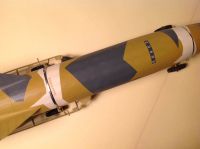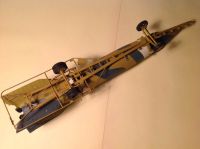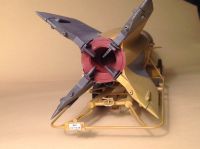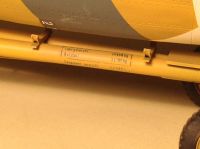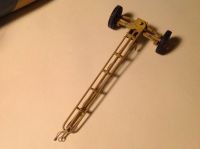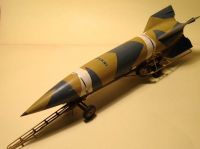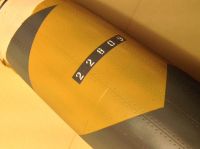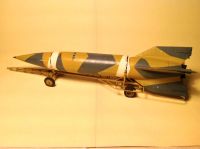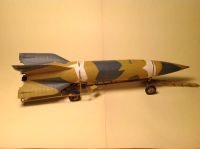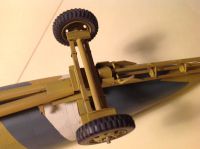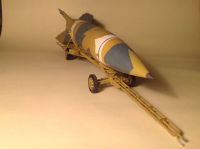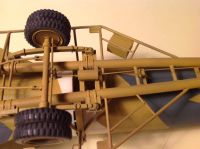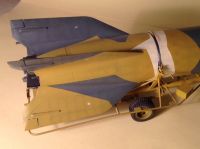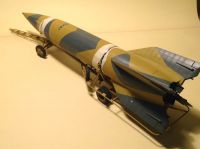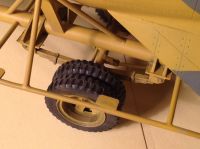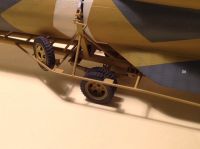Dragon 1/35 V2/A4 Rocket
By Russell Bucy

Introduction
This is my Dragon 1/35 V2/A4 Rocket on a scratchbuilt Vidalwagen road transport trailer. Yes, I know it's not a Large Scale Plane, but it is the "Granddaddy" of the space program, and as such has a special place in the history of flight, despite its dark beginnings. One of the scientists developing the A4 was even heard to remark "...with four or five more of these engines, we could reach the moon". A prophetic thought for the dark days of WWII.
A Short History
I won't go into a lot of detail on the V2. If you want more information, I recommend v2rocket.com, which is a good on-line source, and the book Hitler's Rocket Soldiers, which relates first hand reports and equipment descriptions from the men who developed, built and fired the missile during testing and combat operations. The V2 weighed 8,838 lbs unfueled, and was transported from the factory to the operations area by railcar, where it was off-loaded using a standard Wehrmacht overhead crane system onto a "Vidalwagen" road trailer, the warhead was attached, and the rocket was prepared for road travel. The trailer was made by the Vidal Equipment company, hence the nickname "Vidalwagen". From the railhead, the Vidalwagen was towed by a Hanomag SS100 "Schwere Wehrmacht Schlepper" tractor to the launch area, and then transferred via another overhead crane to a Meillerwagen, the service and erecting trailer which positioned the missile on the launch table. Once the rocket was placed on the Meillerwagen, the Vidalwagen would be towed back to the railhead for another load. It was a laborious process, but the rocket troops were hand-picked specialists. A good rocket crew could complete the launching process in about three hours.
The Model
The rocket is the Dragon 1/35 V2 rocket, which is inaccurate in several areas, but overall, it looks like a V2. The Vidalwagen was entirely scratchbuilt with the exception of the wheels/tires, rear tow shackle, and a tool box on the right side which were "robbed" from an Italeri 1/35 Opel Blitz cargo truck. Everything else is a combination of Evergreen styrene sheet, tube and strip, or K&S brass rod. No plans exist that I'm aware of for a Vidalwagen in 1/35 scale. And the only kit of the Vidalwagen I'm aware of is a 1/72 offering from Special Hobby. For that matter, only one Vidalwagen exists today, at the RAF Museum in Cosford England. I used the 1/72 Special Hobby kit for approximate dimensions and details, and photos from RAF Cosford to draw a set of "sketches" for the Vidalwagen. I also used Internet photos from v2rocket.com. Once I had measurements, I drew a very rough set of plans.
Construction
- The "plans" (really nothing more than a basic sketch) were positioned under a sheet of glass, and lengths of K&S brass tube and rod were annealed, bent and cut to conform to the "sketch". They were then taped to the glass and soldered in position for a fairly strong exterior frame. The appropriate lengths and circumferences of styrene tube were cut, and similarly taped to the glass at the proper angles and glued together.
- A jig was constructed from balsa for the trailer tongue, which held the three main brass components together while they were soldered to a central shaft that would later accommodate the towing "lunette". The spacers on the inside of the trailer tongue are made from sheet styrene.
- The "fifth wheel" connection on the trailer "tongue" was made from bits of sheet styrene, styrene tube, and the rounded head of a push-pin, which fits into a socket made of styrene tube.
- The chassis leaf springs are strips of Evergreen styrene, individually bent over an ellipse shaped balsa "wedge" and glued together with liquid cement which causes them to hold the "bend". They were then attached to scratched styrene supports and the styrene axle housings were attached to them. The axles themselves are brass rod.
- The rear towing shackle, wheels and tool box from an old Italeri 1/35 Opel Blitz kit were attached to the frame with Cyanoacrylate and liquid cement.
- Miniature brass screws and resin nuts were used for the rear tie down points, while wire and styrene channel formed the forward tie down points. A length of polished lead sheet was cut in strips to form the tie-down straps.
- The Dragon V2 has some shape and accuracy problems, but it looks like a V2. I separated the control surfaces from the fins and reattached them, made a combustion chamber from a "gum ball machine" capsule (the plastic kind that contained a toy) and reworked the rocket control vanes at the combustion chamber. I also "oil canned" the entire skin, to give it a more authentic look, as most of the operational V2s had this feature. It is surprising how crude the original structure really was, and a quick study of photographs demonstrates the "rough" construction of the outer skin, which was welded, not riveted as depicted in the kit, but I didn't bother to correct it on this model.
- Markings were cobbled together from various decal sheets, or printed on my HP bubble jet printer. The werke numbers were taken from the V2 missile on display at the National Museum of the USAF at Wright-Patterson AFB. Paints were a combination of Model Master and Tamiya Acrylic Lacquer.
Conclusions
This Vidalwagen gives a different option for displaying the V2 Rocket. Takom has since released a more accurate missile along with a Meillerwagen and an SS100 tractor, which I have in my stash, but so far there are no Vidalwagen kits in large scale available. It was a fun and relatively quick build, taking me about 45 hours to complete. The most difficult single aspect of the build was to use the 1/72 scale kit to get the dimensions right for the plans, then drawing the plans themselves. Once that was done, it was really only a matter of cutting, bending and attaching styrene and brass tubes and rods together.
References
- "Germany's Secret Weapons of WWII", Roger Ford; MBI Publishing
- "Hitler's Rocket Soldiers", Murray Barber & Michael Keuer; Tattered Flag Publishers
- "The History of Space Vehicles", Tim Furniss; Thunder Bay Press
- V2rocket.com; http://www.v2rocket.com/
- Nat'l Museum of the USAF, W-P AFB, Ohio; http://www.nationalmuseum.af.mil/
- The RAF Museum, Cosford England; https://www.rafmuseum.org.uk/cosford/
© Russell Bucy 2017
This article was published on Wednesday, July 19 2017; Last modified on Wednesday, July 19 2017


